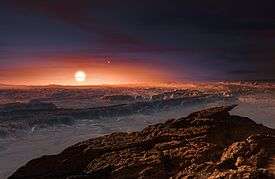Kepler-1647b
| Exoplanet | List of exoplanets | |
|---|---|---|
| Parent star | ||
| Star | Kepler-1647 | |
| Constellation | Cygnus | |
| Right ascension | (α) | 19h 52m 36.02s[1] |
| Declination | (δ) | +40° 39′ 22.2″ |
| Apparent magnitude | (mV) | ~13.54 (estimated) |
| Distance | 3700 ly (1134 pc) | |
| Mass | (m) | 1.22[1] M☉ |
| Radius | (r) | 1.79[1] R☉ |
| Temperature | (T) | 6210 K |
| Metallicity | [Fe/H] | -0.14±0.05 |
| Age | 4.4 Gyr | |
| Physical characteristics | ||
| Mass | (m) | 1.52±0.65 MJ |
| Radius | (r) | 1.06±0.0123 RJ |
| Orbital elements | ||
| Semi-major axis | (a) | 2.7205±0.007[1] AU |
| Eccentricity | (e) | 0.0581[1] |
| Orbital period | (P) | 1107.6±0.023[1] d |
| Inclination | (i) | ~90.1[1]° |
| Discovery information | ||
| Discovery date | June 13, 2016 | |
| Discoverer(s) | ||
| Discovery method | Transit | |
| Discovery site | Kepler Space Observatory | |
| Discovery status | ||
| Other designations | ||
WISE J195236.01+403921.8 b; 2MASS J19523602+4039222 b; KIC 5473556 b; Kepler-1647(AB)-b | ||
Kepler-1647b (sometimes named Kepler-1647(AB)-b to distinguish it from the secondary component) is a circumbinary exoplanet that orbits the binary star system Kepler-1647, 3,700 light-years (1,100 pc) from Earth in the constellation Cygnus.[2] It was announced on June 13, 2016 in San Diego at a meeting of the American Astronomical Society.[2] It was detected using the transit method, when it caused the dimming of the primary star, and then again of the secondary star blended with the primary star eclipse.[3] The first transit of the planet was identified in 2012, but at the time the single event was not enough to rule out contamination, or confirm it as a planet.[3] It was discovered by the analysis of the Kepler light-curve, which showed the planet in transit.
Characteristics
Mass and orbit
The exoplanet is a gas giant, similar in size to Jupiter, and has an orbital period of 1107 days.[3] This is the longest transit period of any confirmed transiting Kepler exoplanet discovered yet.[2] It is also the largest circumbinary Kepler planet known.[3] It is 483±206 times more massive than earth, and 1.52±0.65 times Jupiter's mass.[1]
Host stars
The star system, Kepler-1647 (also known as 2MASS J19523602+4039222, KOI-2939, and KIC 5473556), is a binary star with the primary star (Kepler-1647 A) having a mass of 1.22 M☉, a radius of 1.79 R☉, and a surface temperature of 6210 ± 100 K. The secondary star (Kepler-1647 B), on the other hand, has a mass of 0.975 M☉, a radius of 1.79 R☉, and a surface temperature of 5770 K. In comparison, the Sun has a surface temperature of 5778 K.[4] The binary star system's age is estimated to be about 4.4 billion years old, about 200 million years younger than the Sun.
Habitability
Kepler-1647b is in the habitable zone of the star system.[2][3] Since the planet is a gas giant, it is unlikely to host life. However, hypothetical large moons could potentially be suitable for life.[2][3] However, large moons are usually not created during accretion near a gas giant. Such moons would likely have to be captured separately, e.g., a passing protoplanet caught into orbit due to the gravitational field of the giant planet.
See also
References
- 1 2 3 4 5 6 7 8 "Kepler-1647b – NASA Exoplanet Archive". Retrieved June 14, 2016.
- 1 2 3 4 5 "New Planet Is Largest Discovered That Orbits Two Suns". NASA. June 13, 2016. Retrieved June 14, 2016.
- 1 2 3 4 5 6 Kostov, Veselin B.; Orosz, Jerome A.; Welsh, William F.; Doyle, Laurance R.; Fabrycky, Daniel C.; Haghighipour, Nader; Quarles, Billy; Short, Donald R.; Cochran, William D.; Endl, Michael; Ford, Eric B.; Gregorio, Joao; Hinse, Tobias C.; Isaacson, Howard; Jenkins, Jon M.; Jensen, Eric L. N.; Kane, Stephen; Kull, Ilya; Latham, David W.; Lissauer, Jack J.; Marcy, Geoffrey W.; Mazeh, Tsevi; Muller, Tobias W. A.; Pepper, Joshua; Quinn, Samuel N.; Ragozzine, Darin; Shporer, Avi; Steffen, Jason H.; Torres, Guillermo; et al. (2015). "Kepler-1647b: the largest and longest-period Kepler transiting circumbinary planet". The Astrophysical Journal. 827: 86. arXiv:1512.00189 [astro-ph.EP]. Bibcode:2016ApJ...827...86K. doi:10.3847/0004-637X/827/1/86. Cite uses deprecated parameter
|class=(help) - ↑ Fraser Cain (15 September 2008). "Temperature of the Sun". Universe Today. Retrieved 19 February 2011.

.jpg)
